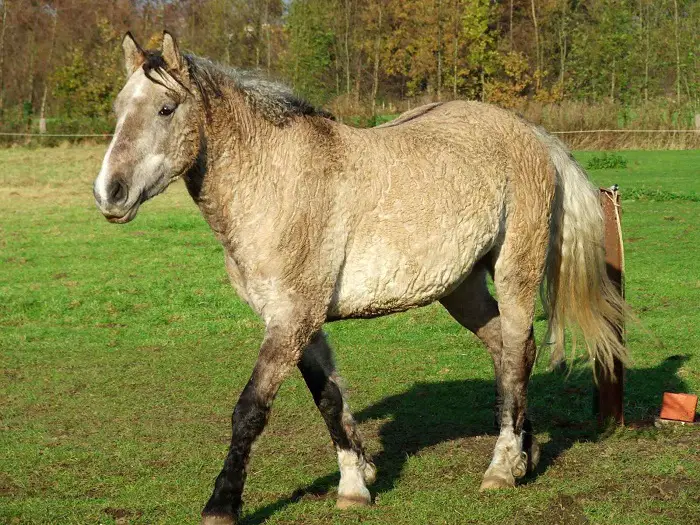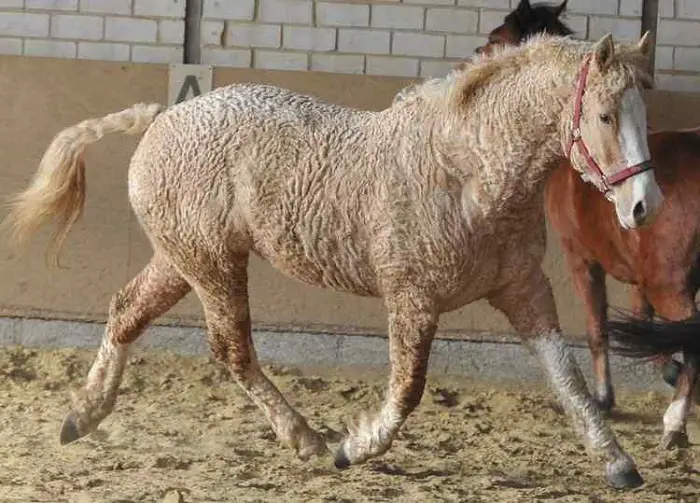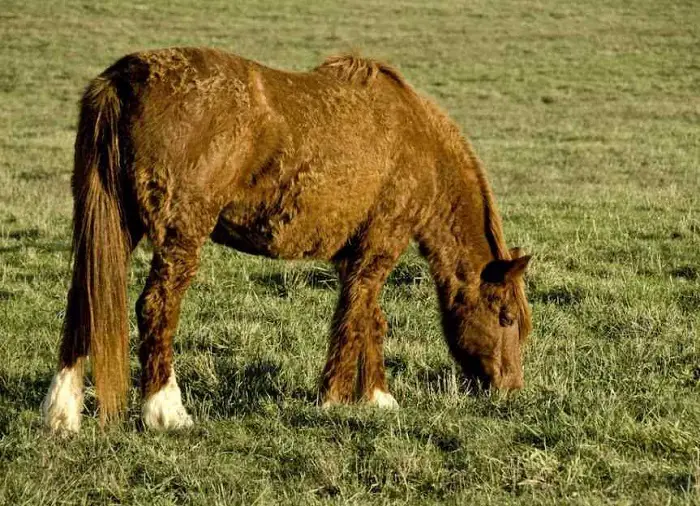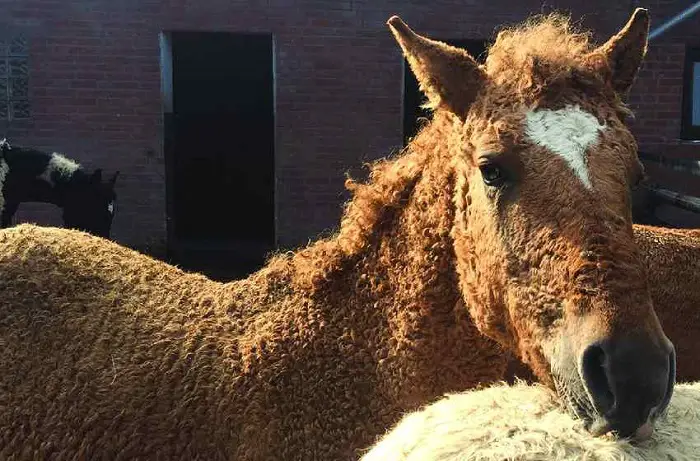The Bashkir Curly Horse, also known as the Bashkir horse or Curly horse, is a fascinating and unique breed that captures the attention of enthusiasts worldwide. With its distinct curly coat and versatile nature, the Bashkir Curly Horse stands out among other horse breeds. Originating in the United States but named after the Bashkir region in Russia, this breed has gained popularity for its striking appearance, hypoallergenic qualities, and adaptable temperament.
Origin and History of Bashkir Curly Horse
The origin and history of the Bashkir Curly Horse is an intriguing tale that spans continents and generations. While some mysteries still surround their precise origins, several theories and historical accounts shed light on the breed’s development.
- Origins in North America: The Bashkir Curly Horse’s history begins in North America, particularly in the western regions of the United States of America and Canada. It is believed that the breed’s ancestors included wild mustangs and curly-coated horses that roamed the North American continent.
- Discovery by the Dorrance Family: In the early 20th century, a ranching family named Dorrance discovered a herd of curly-coated horses in the Nevada desert. The family was known for their horsemanship skills and their influential contributions to developing natural horsemanship techniques. They recognized the unique qualities of the curly-coated horses and began selectively breeding them.
- Influence of Russian Bashkir Horses: The name “Bashkir” is derived from the Bashkir people, an ethnic group from the Bashkir region in Russia. The curly-coated horses found in North America were later associated with the Russian Bashkir horses due to their similar appearance. However, it is essential to remember that there is no documented evidence of direct influence or breeding with Russian Bashkir horses in the breed’s development.
- Formal Recognition and Breed Formation: In the mid-20th century, curly-coated horses began to receive recognition as a distinct breed. In 1971, the American Bashkir Curly Registry (ABCR) was established to maintain a studbook for the breed and preserve its unique characteristics. The registry’s primary goal was establishing the Bashkir Curly Horse as a recognized breed, separate from other curly-coated horse breeds.
- Further Development and Breed Expansion: Breeders continued to refine and develop the Bashkir Curly Horse over the years. The focus was on preserving the breed’s distinctive curly coat and enhancing its versatile nature, gentle temperament, and hypoallergenic qualities. Selective breeding programs were implemented to maintain and improve these traits.
Today, the Bashkir Curly Horse has gained recognition and popularity worldwide. At the same time, the breed’s primary population is still in North America. The Baskhir horse can also be found in other countries, including Europe and Australia. The breed continues to captivate horse enthusiasts and owners with its unique appearance, adaptability, and hypoallergenic qualities.
Despite the ongoing research and speculation regarding their origins, the Bashkir Curly Horse remains a fascinating breed with a rich history rooted in North America’s vast landscapes and breeders’ dedication to preserving their exceptional traits.
Physical Features of American Bashkir Curly
The American Bashkir Curly, also known as the Bashkir Curly Horse or simply Curly Horse, possesses distinctive physical features that contribute to its unique appearance. Here are the key physical characteristics of the American Bashkir Curly:
- Curly Coat: The most notable and defining feature of the American Bashkir Curly is its curly coat. The curls can range from loose waves to tight ringlets and are present on the horse’s body, mane, and tail. The curly coat sets them apart from other horse breeds and adds to their visual appeal.
- Hypoallergenic Qualities: Another notable feature of the American Bashkir Curly is its hypoallergenic qualities. Many individuals allergic to horses find they can tolerate being around Bashkir Curlies due to their low dander and reduced allergen levels. This characteristic makes them a suitable choice for people with horse allergies.
- Medium-sized Build: American Bashkir Curlies typically have a medium-sized build. They range in height from 14 to 16 hands (56 to 64 inches or 142 to 163 cm) at the withers. They have a well-muscled body, strong legs, and a sturdy frame contributing to their endurance and versatility.
- Various Colors and Patterns: American Bashkir Curlies come in various colors and patterns. They can be solid-colored, including bay, chestnut, black, or gray. Additionally, they may display patterns such as pintos, roans, and appaloosa-like markings. The variety of coat colors and patterns adds to the breed’s visual diversity.
- Well-Defined Head: American Bashkir Curlies have a well-proportioned head with a straight or slightly concave profile. Their eyes are expressive and set well apart. The breed commonly possesses medium-sized, alert ears contributing to its aesthetic appeal.
- Strong Hooves: American Bashkir Curlies are known for their solid and sturdy hooves. This trait enhances their sure-footedness and makes them well-suited for traversing various terrains, including rugged trails and challenging landscapes.
- Gentle Expression and Intelligent Eyes: The American Bashkir Curly is known for its gentle expression, often characterized by a kind and intelligent look in its eyes. Their calm and intelligent temperament is often reflected in their facial expression, making them appear approachable and friendly.
These physical features collectively contribute to the breed’s unique and captivating appearance.
Height and Weight and Bashkir Curly
The height and weight of the Bashkir Curly Horse can vary somewhat depending on the individual horse and its specific bloodlines. However, I can provide you with general ranges typically seen in the breed:
Height: At the withers, Bashkir Curlies usually stand between 14 hands (56 inches or 142 cm) and 16 hands (64 inches or 163 cm). However, some individuals may fall slightly outside this range.
Weight: The weight of a Bashkir Curly can vary depending on factors such as height, build, and overall condition. On average, an adult Bashkir Curly can weigh between 900 pounds (408 kg) and 1,200 pounds (544 kg).
Color and Markings of American Bashkir Curly
The American Bashkir Curly is known for its wide range of colors and markings, adding to its visual diversity and appeal. Here are some of the possible colors and markings you may find in American Bashkir Curlies:
- Solid Colors: American Bashkir Curlies can come in solid colors such as bay, chestnut, black, and gray. These solid coat colors are often seen in the breed and provide a classic and elegant appearance.
- Pintos: Pinto is a term used to describe horses with large patches of white and another base color. American Bashkir Curlies can display pinto patterns, including overo, tobiano, and tovero. Pinto patterns can range from minimal white markings to predominantly white horses with patches of color.
- Roans: Roan is a coat pattern characterized by white and colored hairs. American Bashkir Curlies can have roan patterns such as blue roan or red roan. Roan horses have a uniform distribution of white hairs mixed with the base coat color, creating a subtle and attractive appearance.
- Appaloosa-like Patterns: Some American Bashkir Curlies exhibit appaloosa-like patterns, similar to the Appaloosa breed. These patterns include spots, speckles, or blanket patterns on a solid or roan-colored base coat. The spots can be of various sizes and shapes, adding an eye-catching element to the horse’s appearance.
- Other Patterns: In addition to the colors as mentioned above and markings, American Bashkir Curlies can also display other patterns such as sabino, which typically involves white markings on the face and legs, and various dilution genes like dun or buckskin, which modify the base coat color.
The Behavior of Bashkir Curly Horse
The Bashkir Curly Horse is known for its gentle and intelligent nature, making it a breed with desirable behavioral traits. Here are some key characteristics of the Bashkir Curly Horse’s behavior:
- Calm and Gentle: Bashkir Curlies are generally known for their calm and gentle demeanor. They have a kind and willing temperament, which makes them well-suited for various equestrian activities. They tend to be patient and tolerant, making them suitable for riders of different skill levels, including beginners.
- People-Oriented: Bashkir Curlies are known to be people-oriented horses. They often form strong relationships with their owners and enjoy human companionship. They are often eager to please and are willing workers, making them responsive to training and enjoyable to work with.
- Intelligent and Willing to Learn: The breed is recognized for its intelligence and willingness to learn. Bashkir Curlies are quick learners and generally display a good level of trainability. The horses are adaptable and can excel in various disciplines with proper training and guidance.
- Versatile: Bashkir Curlies have a reputation for being versatile horses. They can perform well in various equestrian activities, including trail riding, endurance riding, dressage, jumping, driving, and Western disciplines. Their hardiness, sure-footedness, and endurance contribute to their ability to handle different terrains and tasks.
- Affectionate and Bonding: Bashkir Curlies often develop strong bonds with their owners and caretakers. They can be affectionate and enjoy human interaction. Many owners report that Bashkir Curlies have a natural affinity for people and seek out social connections.
- Curiosity and Playfulness: Bashkir Curlies are known for their curious and playful nature. They can be curious about their surroundings, making them enjoyable to engage with. Their playful behavior can also contribute to their overall temperament and make them entertaining companions.
Feed and Nutrition of American Bashkir Curly
The feed and nutrition requirements of the American Bashkir Curly, like any horse, depend on factors such as age, weight, activity level, and overall health. Here are some general guidelines for feeding and nutrition for American Bashkir Curlies:
- Forage: High-quality forage should form the foundation of a Bashkir Curly’s diet. This includes access to good pasture or grass hay. Horses are natural grazers, so providing ample forage is essential for their digestive health. The forage should be clean, mold-free, and offered in sufficient quantities to meet their daily needs.
- Concentrates: Depending on the horse’s workload and nutritional requirements, concentrates such as grains, pelleted feeds, or complete feeds may be added to their diet. The specific type and amount of concentrate will vary based on individual needs, so it’s recommended to consult with an equine nutritionist to determine the appropriate feed and portion sizes.
- Water: Access to fresh and clean water is essential for all horses, including American Bashkir Curlies. Horses should always have free access to clean water to stay hydrated and support horse’s health and digestion.
- Mineral and Salt Supplements: To ensure proper mineral balance, a Bashkir Curly diet may need to be supplemented with minerals and salts. A veterinarian or equine nutritionist can help assess if any specific deficiencies or imbalances exist and recommend appropriate supplements.
- Feeding Schedule: Establishing a regular feeding schedule is beneficial for Bashkir Curlies. They generally thrive on a consistent routine, and dividing their daily feed into several smaller meals can help mimic their natural grazing behavior and aid digestion.
- Weight Management: It’s essential to monitor the weight of the Bashkir Curly and adjust their feed accordingly. Some individuals may be more prone to weight gain or loss, so their diet should be tailored to maintain a healthy body condition score.
Remember, individual horses may have specific dietary needs or restrictions based on health conditions or sensitivities, so it’s always recommended to consult with a veterinarian or equine nutritionist for personalized feeding recommendations.
Care and Management of Bashkir Curlies
The care and management of a Bashkir Curly Horse are crucial for its overall health, well-being, and longevity. Here are some essential aspects to consider when caring for and managing a Bashkir Curly:
- Shelter and Environment: Provide a suitable shelter to protect the horse from extreme weather conditions, such as heat, cold, wind, and rain. The shelter should be well-ventilated, secure, and have ample space for the horse to move comfortably. Ensure the pasture or turnout area is safe, free from hazards, and provides adequate grazing or forage.
- Feeding and Nutrition: Provide a balanced diet of high-quality forage, pasture, grass, or hay and appropriate concentrates or supplements. Feed according to the horse’s age, weight, activity level, and any specific dietary requirements or restrictions. Ensure access to clean, fresh water at all times.
- Regular Veterinary Care: Establish a relationship with a veterinarian experienced in equine care. Schedule routine veterinary check-ups to monitor the horse’s health, administer vaccinations, and conduct dental exams and treatments. Follow a deworming schedule recommended by the veterinarian to prevent parasite infestations.
- Hoof Care: Regular hoof care is essential for the horse’s well-being. Schedule routine visits from a professional farrier or trimmer trimming the hooves and address any hoof-related issues. This helps maintain proper hoof health, balance, and soundness.
- Exercise and Mental Stimulation: Provide regular and mental stimulation for the Bashkir Curly. This includes daily turnout, riding, groundwork, or natural horsemanship exercises. Enrichment activities, such as puzzles, toys, or varied training exercises, can provide mental stimulation.
- Grooming: Regular grooming helps maintain the horse’s coat, skin, and cleanliness. Brush the coat to remove dirt, debris, and loose hair. Pay attention to the curly coat, which may require special care to prevent matting or tangling. Check for any signs of skin issues or abnormalities during grooming sessions.
- Social Interaction: Horses are social animals; providing social interaction is essential for their well-being. Consider providing the Bashkir Curly with equine companionship. Horses thrive when they can interact and establish social bonds with other horses.
- Safety and Security: Ensure the horse’s environment is safe and secure. Inspect fencing, gates, and other equipment to prevent accidents or escapes. Provide safe handling and appropriate safety measures during all interactions with the horse.
- Mental and Emotional Well-being: Pay attention to the horse’s mental and emotional well-being. Spend quality time bonding with the horse, providing positive reinforcement, and creating a trusting and respectful relationship. Understand and respond to the horse’s behavioral cues and needs.
The Health of American Bashkir Curly
The American Bashkir Curly is generally considered a hardy and healthy breed with no specific breed-related health concerns. However, as with any horse breed, they are still susceptible to specific health issues affecting their overall well-being. Here are some common health considerations for American Bashkir Curlies:
- Laminitis: Laminitis is a painful disease that affects the hooves, specifically the laminae, which connect the hoof wall to the coffin bone. Equine laminitis can be caused by various factors such as obesity, metabolic issues, or excessive carbohydrate intake. Maintaining a balanced diet, monitoring weight, and providing regular exercise can help reduce the risk of laminitis.
- Equine Metabolic Syndrome (EMS): EMS is a metabolic disorder that can lead to weight gain, insulin resistance, and laminitis. Some horses may be genetically predisposed to EMS. Proper diet, regular exercise, and veterinary monitoring can help manage and prevent EMS.
- Cushing’s Disease (PPID): Pituitary Pars Intermedia Dysfunction (PPID), commonly known as Cushing’s Disease, is a hormonal disorder that affects older horses. It can cause symptoms such as weight loss, increased thirst and urination, and a long, curly coat that doesn’t shed properly: regular veterinary check-ups and appropriate management.
- Equine Recurrent Uveitis (ERU): ERU, known as moon blindness, is an inflammation of the eye’s inner structures. It can cause recurring episodes of pain, redness, and discharge. ERU is more common in some breeds, including the American Bashkir Curly. Early detection and prompt veterinary treatment are essential to manage this condition and prevent vision loss.
- Skin Conditions: The curly coat of Bashkir Curlies may require special care to prevent skin issues such as dermatitis or skin infections. Regular grooming, proper hygiene, and monitoring for any signs of skin irritation or abnormalities can help maintain skin health.
- Routine Veterinary Care: Regular veterinary check-ups, vaccinations, dental care, and deworming are essential for maintaining the overall health of American Bashkir Curlies. Follow a recommended schedule for routine veterinary care to ensure their well-being.
Versatile Uses of American Bashkir Curlies
The American Bashkir Curly is a versatile breed that can excel in various equestrian disciplines and activities. Their unique curly coat and adaptable nature make them well-suited for various uses. Here are some of the versatile uses of the American Bashkir Curly:
- Trail Riding: Bashkir Curlies are often used for trail riding due to their sure-footedness, endurance, and calm temperament. They can navigate different terrains and provide trail enthusiasts with a comfortable and enjoyable ride.
- Endurance Riding: The endurance riding discipline requires horses to cover long distances at a controlled pace. Bashkir Curlies’ natural endurance and stamina will suit this demanding sport. Their hardiness and ability to handle varying terrains contribute to their success in endurance competitions.
- Dressage: Dressage is an equestrian discipline focusing on precise movements and communication between horse and rider. With their intelligence, willingness to learn, and natural athleticism, Bashkir Curlies can excel in dressage. Their trainability and ability to perform intricate movements make them suitable for various dressage levels.
- Jumping: Bashkir Curlies can participate in show jumping or other jumping disciplines. They can develop the skills and athleticism needed to navigate jumping courses with proper training and conditioning. Their versatility and willingness to work make them enjoyable partners for jumping enthusiasts.
- Driving: Bashkir Curlies can be trained for driving in the traditional carriage or other disciplines such as combined driving. Their strength, agility, and cooperation make them suitable for pulling a carriage or participating in driving competitions.
- Western Riding: Bashkir Curlies can excel in various Western riding disciplines, including reining, cutting, and Western pleasure. Their versatile nature allows the horse to adapt to the Western riding style, and their calm demeanor makes them suitable for ranch work, trail classes, and other Western activities.
- Therapy and Assistance Work: Due to their gentle nature and people-oriented temperament, Bashkir Curlies are sometimes used in therapeutic riding programs. Their calm demeanor and willingness to connect with humans can benefit individuals with physical, emotional, or cognitive disabilities. They can also be trained to assist individuals with mobility or other special needs.
Their adaptability, intelligence, and willingness to learn make them suitable for various equestrian activities and roles, catering to their owners’ or riders’ preferences and goals.
Final Talk on Bashkir Curly Horse
The Bashkir Curly Horse, known for its unique curly coat and versatile nature, is a breed that captures the hearts of many equestrians and horse enthusiasts. With its distinctive appearance and desirable traits, the Bashkir Curly has gained popularity across various disciplines and activities.
Beyond its striking appearance, the Bashkir Curly possesses a calm and gentle temperament, making it an ideal partner for riders of all skill levels. These horses are intelligent, willing to learn, and often form strong bonds with their owners.



